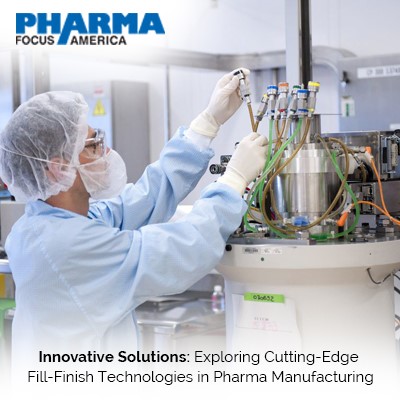
The article explores the evolution, innovations, benefits, challenges, and future trends of cutting-edge fill-finish technologies in pharmaceutical manufacturing. It emphasizes improved product quality, efficiency, safety, and the necessity for pharmaceutical companies to embrace these advancements to meet evolving demands and regulatory standards for global healthcare improvement.

Introduction:
Pharmaceutical manufacturing has seen remarkable progress in recent times, particularly in the domain of fill-finish technologies. These advancements are pivotal in upholding the standards of quality, efficiency, and safety in pharmaceutical products. In this article, we delve deep into the realm of cutting-edge fill-finish technologies to uncover their transformative impact on the industry. We will explore not only the evident benefits these technologies bring but also the challenges they pose and the promising future they herald for pharmaceutical manufacturing.
Evolution of Fill-Finish Technologies
Fill-finish processes, which involve filling containers with pharmaceutical products and sealing them, have evolved from manual operations to highly automated systems. Traditional methods often posed challenges such as variability, contamination risks, and slower production rates. However, advancements in technology have addressed these issues, leading to more precise, reliable, and efficient fill-finish processes.
Key Innovations
Cutting-edge fill-finish technologies in pharmaceutical manufacturing encompass several key innovations. Advanced robotics have transformed operations by providing consistency, accuracy, and speed. Robotic arms can execute tasks like filling, capping, labeling, and inspection with remarkable precision, mitigating human error and boosting throughput. Single-use systems have gained popularity for their flexibility, cost-effectiveness, and reduced risk of cross-contamination. Components like disposable bags, tubing, and connectors streamline processes and enable swift transitions between different products. Closed systems are crucial for minimizing contaminant exposure and preserving product integrity throughout production. They effectively block environmental contaminants and safeguard operators from hazardous substances, ensuring compliance with regulatory standards and product safety. Additionally, intelligent monitoring and control systems, incorporating sensors, data analytics, and real-time monitoring, provide precise control over fill-finish parameters such as volume, temperature, and pressure. This feedback loop facilitates immediate adjustments, optimizing product quality while minimizing waste, contributing to efficient and high-quality pharmaceutical manufacturing processes.
Benefits of Cutting-Edge Fill-Finish Technologies
Cutting-edge fill-finish technologies offer a plethora of benefits that significantly impact pharmaceutical manufacturing. Firstly, these innovations contribute to improved product quality by ensuring consistency and reducing variability, ultimately enhancing patient safety. Secondly, the integration of automation and robotics leads to enhanced efficiency, resulting in higher throughput and reduced production times. This efficiency translates into cost savings, as single-use systems and optimized processes lower operational costs by minimizing equipment cleaning, validation efforts, and downtime. Additionally, these technologies prioritize compliance and safety by utilizing closed systems and intelligent monitoring, ensuring adherence to regulatory requirements and enhancing operator safety. Overall, the adoption of cutting-edge fill-finish technologies not only improves operational performance but also fosters a culture of quality, efficiency, and safety within pharmaceutical manufacturing.
Challenges and Considerations
Despite the numerous benefits, adopting cutting-edge fill-finish technologies presents challenges such as initial investment costs, technology integration complexities, and the need for skilled personnel to operate and maintain these systems. Additionally, ensuring compatibility with existing manufacturing infrastructure and regulatory requirements requires careful planning and execution.
Future Trends
The future of fill-finish technologies in pharmaceutical manufacturing is marked by a trajectory of ongoing innovation and advancement. One key area of focus is Smart Manufacturing, which involves the integration of artificial intelligence, machine learning, and predictive analytics. This integration enables proactive maintenance, process optimization, and enhanced quality control, leading to more efficient and reliable production processes. Another significant trend is the integration of Industry 4.0 principles, such as connectivity, data exchange, and automation. This integration streamlines production workflows, facilitates real-time decision-making, and enhances overall operational efficiency. Furthermore, the future of fill-finish technologies will also see a shift towards personalized medicine. This includes tailoring fill-finish processes to accommodate the growing demand for personalized therapies, including small-batch production and customized formulations. Embracing these future trends not only ensures pharmaceutical manufacturers stay competitive but also enables them to meet evolving consumer needs and regulatory requirements effectively.
Conclusion
The evolution of cutting-edge fill-finish technologies has indeed revolutionized the landscape of pharmaceutical manufacturing. These innovations have ushered in a new era characterized by enhanced quality, efficiency, and safety across the production process. The meticulous precision and reliability brought about by these technologies not only ensure consistent product quality but also streamline operations, leading to increased efficiency and reduced production times. Moreover, the emphasis on safety through measures like closed systems and intelligent monitoring reinforces regulatory compliance and enhances operator safety.
Looking ahead, the imperative for pharmaceutical companies to embrace these advancements cannot be overstated. Staying competitive in a dynamic industry requires leveraging the latest technologies to meet evolving consumer demands and stringent regulatory standards. Furthermore, the ultimate beneficiaries of these advancements are patients worldwide, who receive high-quality pharmaceutical products that are the result of cutting-edge fill-finish technologies.
In conclusion, the continuous innovation and adoption of cutting-edge fill-finish technologies are not just trends but necessities for pharmaceutical manufacturers. Embracing these advancements is not only about staying ahead but also about fulfilling the industry's commitment to delivering safe, effective, and reliable medications to improve global healthcare outcomes.